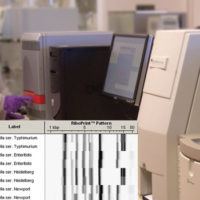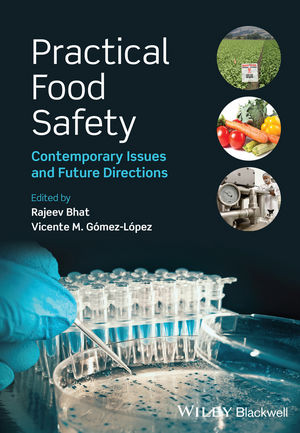Aptamers (from the Latin aptus meaning “fit” and the Greek meros meaning “part”) or “part that fits” are a relatively new arrival on the food safety testing scene, demonstrating immediate potential to significantly change our capability in isolating and interrogating bacteria and viruses.
Aptamers are amino acid molecules that are synthesized in high volumes by polymerase chain reaction (PCR). Functionally, aptamers that are formatted in assays perform the familiar “lock & key” binding to either proteins or chemical molecules, and the results of this binding reaction then enables the detection of the material (protein or chemical) of interest.
Aptamers may also be used to “capture” and concentrate bacteria or virus within a sample. The implications of using aptamers in sample concentration are increased sensitivity and specificity of assays with lower detection limits. Aptamers conjugated to magnetic beads may be used to isolate bacteria or virus in samples.
The methods used to develop and manufacture aptamers provide significant advantages in reagent performance. Aptamers can be “fine tuned” by repetitive rounds of increasingly specific physical structure refinement of their amino acid sequence to meet challenging applications. Because aptamers are manufactured with precision by chemical reactions, their use in assays eliminates the concern of lot-to-lot variations in performance.
The Lost Decades of Aptamers
For almost two decades, the scientific exploration and development of aptamers as important reagents has been constrained by patent protections associated with the science of their creation by an iterative process known as “Selex.” Until recently, other than the work of the Selex patent holder, development work with aptamers has been mostly limited to producing reagents and diagnostic assays for government, homeland security, NASA and military use.
For over a decade, government grants have been issued to develop aptamer-based assays that address some of our most challenging needs in human diagnostic, therapeutic and military applications. Recently, the U.S. government has issued statements confirming that aptamers are acceptable reagents for government contract and grant proposals—an important endorsement of the value of aptamers.
Beyond food safety testing, aptamers are now demonstrating impressive capability in private sector human health diagnostics and therapeutic applications.
With the recent expiration of Selex patents, aptamers are now being used to develop commercial/industrial assays, human diagnostic tests and human therapeutic drugs.
Advantages of Aptamers
Speed: Aptamer-based assays benefit from sensitivity/specificity that is comparable to PCR performance and significantly larger aliquot volume analyzed. This combination of accuracy and sample size offer the industry unbeatable speed to an accurate result.
Green & Sustainable: Aptamers are molecules manufactured from amino acids in a chemical reaction without the use of any animals or biologics, eliminating lot-to-lot variations.
Dynamic: Aptamers can be “fine tuned” in the development process to “optimize” reactivity with the target protein or chemical. This process of optimizing the aptamer assures that, for example, a Listeria assay does actually detect the entire Listeria genus. Another benefit of fine tuning is the ability to distinguish viable from nonviable (living vs. dead) virus.
Flexible: Several formats for aptamer-based assays have been developed to meet the needs of a diverse testing community. In addition to familiar lateral flow testing devices, 96-well plates and fluorescent digital readers are available to meet the needs of the end-user.
Costs: Aptamers have a very low cost to manufacture after the aptamer sequences are characterized and the assays are formatted and validated. The cost advantage of not using animals in the production of reagents is a positive step in economics, and reagent purity and sustainability.
Aptamer-Based Assays
Both antibodies and aptamers provide flexibility in format that creates unique advantages when developing food testing assays.
Sandwich Assays: Aptamers may be formatted in a classical competitive sandwich assay format characterized by these three elements:
• An immobilized antibody is bound to a substrate (lateral flow strip or 96-well plate) and exposed to the test sample
• The bacteria of interest in the test sample is “captured” by the immobilized antibody
• A second antibody that is conjugated to a “signal” material (typically latex, colloidal gold or a fluorescent molecule) is bound to the immobilized bacteria and the concentration of “signal” material produces a detectable, observable or measurable indication that the bacteria is present.
Sandwich assays may be developed and manufactured using either antibodies or aptamers. The performance of both is acceptable.
“Lights On” Fluorescent Resonance Energy Transfer (FRET) Assay: Aptamers have a unique advantage in that an aptamer assay may be designed to provide a semi-quantitative result—not limited as capture/signal sandwich assays are—and may provide new capability towards expanding our dependable knowledge of sample status. A “lights on” assay format or “competitive FRET” is characterized by these elements:
• A sample (enriched or otherwise) is mixed with aptamer and reagents initiating the binding of bacteria (or virus) with the aptamer and triggering a detectable fluorescent signal, as the aptamer signal quenching is attenuated in the presence of the binding bacteria, chemical or virus.
• The sample fluorescence is measured in an instrument and reported as either a positive/negative or a fluorescence intensity value or may be expressed as a most probable number (MPN) result. Sample results within just minutes are typical for FRET assays.
The promise of competitive FRET “lights on” beacon assays are expected to provide a dependable, inexpensive, fast, easy-to-use assay capable of detecting norovirus among other challenging pathogens. Published work in detection of foot and mouth disease has demonstrated the utility of FRET assays in detection of virus. For norovirus, it is expected that competitive FRET aptamer assays will take only minutes to produce a test result and have the capability to differentiate live versus dead norovirus—an important advancement in our overall analytical capability as an industry.
Future Implications
In addition to enhanced capability in current testing for pathogens, the implications of aptamer-based assays include potentially significant enhancement in rapid, digital quantitative analysis for indicator organisms that include MPN for generic Escherichia coli and coliforms, Staphylococcus and total aerobic bacteria counts.
Aptamer methods currently in development for pathogens detection have demonstrated significant performance benefits in speed to results. Aptamer assays have the potential to shorten enrichment times by up to 50% or more.
STEC: The U.S. Department of Agriculture is currently funding research to develop aptamers for pathogenic E. coli O157 and the six regulated non-O157 shiga toxin-producing E. coli (STEC) O26, 045, O103, O111, O121 and O145. These developments, when commercialized, will allow industry to determine the status of samples much more quickly than currently possible. Aptamer assays leverage the combined effects of larger sample size and increased reagent sensitivity (lower detection limits) to offer a method capable of detecting STEC after 8 hours enrichment of a 375-g sample compared with current 14-hour requirements.
Listeria: Recent studies by commercial food testing laboratories have confirmed that aptamer-based methods are capable of providing a true Listeria genus, including all Listeria species in little time.
Within 2 years, rapid testing methods using aptamers are expected to be fully commercialized for common testing, including pathogenic E. coli, Salmonella, Listeria and norovirus.
The streamlined process of developing reagents and formatted assays using aptamers is significantly versatile, which will enable significant progress to be made quickly towards developing and commercializing new rapid methods for food testing and other important applications. The efficiency of these breakthroughs in assay development will provide test kit manufacturers with significant economic advantages. For the food industry and testing laboratories, these advances in capability will offer better tests for a wide array of bacteria and virus of concern at lower overall prices.
Jim Byron is a food safety consultant. He can be reached at jimbyron828@gmail.com.
>









